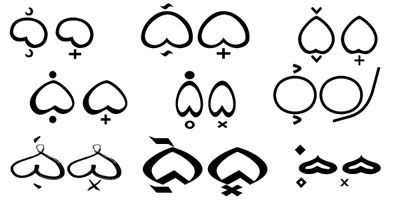
Different styles of kudlit marks.
Cross "Kudlit" - Ang kulit n'yo!
Ever since the Spanish priest Fr. Francisco Lopez introduced the cross-shaped kudlit back in 1620 for the Ilocano printing of Doctrina Cristiana, we have been at odds with "reform". Whether it's truly a matter of principle, or protest, or stubbornness, the two camps of baybáyin practitioners (traditionalists and reformists) need to find a middle ground. While the first two reasons (principle & protest) are reasonable personal choice/preference, the stubborn ones are quite beyond reason.
While some baybayin practitioners might say that the Spaniards (Lopez) "invented" the cross kudlit just to convert more natives into Christianity, that is hearsay (or should I say "heresy"? (sic, pun)). It is true though that the Doctrina Cristiana books were published to take advantage of the native people's literacy. However, the motivation for the friars to "reform" baybáyin script for legibility has its merit in modern typography. The decision to include a baybayin version of the virama (vowel cancellation mark) is not just a spur of the moment "invention" but it is more likely based on a careful study of linguistics by scholars (who happen to also be friars) at the time. Other writing methods (Abugida) related to or predecessors of baybayin have vowel cancellation marks or systems, so adopting a similar system is not entirely unreasonable. Note also that the kavi script in the Laguna Copperplate Inscriptions (LCI), which is dated back to 900CE, used both virama and ligatured glyphs to cancel vowel sounds similar to the methods of other Brahmic scripts and also what is currently being developed for the Súlat Kapampángan version of baybáyin.

A cleaned-up illustration of the Laguna Copperplate inscription
The virama for Tagalog Baybáyin was rejected by natives because they considered the script adequate without it. While that works well for their need at the time, the Filipino languages' lexicon has grown dramatically since then. The need for a virama becomes apparent even when writing the most mundane notes:

Correction on top image: Typo "you're" was supposed to be "you".
When asked to read the sentence above, written in traditional "no dead consonants" method, the most common response was: "bayag mo'y maliit dahil sa utin ng itim na malaki", which means: "your balls are small (shrunk) because of (seeing) the black guy's big organ". Imagine the confusion at a duck farm in Pateros. Incited after a client ordered several breeding pairs of ducks and he received this note along with his bill? When all the poor farmer wanted to convey is, "bayad mo'y maliit dahil sa unti ng itik na malaki", meaning, "your bill is small because we are short on adult itik ducks". The farmer, just wanting to make up for the incomplete order by giving his client a discount, unwittingly conveyed the wrong message.
Whatever your qualms are about the cross kudlit, for baybáyin to be useful in writing normal correspondence these days, the virama is a practical approach. Even the Mangyan "pamudpod" mark, introduced by Dutch anthropologist Antoon Postma, has been better received and is used by the Hanunóo. While the Kapampangan method of vowel cancellation is proving quite useful for both modern & traditional artistic design; although it has its limitations when it comes to modern typography (typing in a word processor and publication) and creating standardized fonts. For arts and crafts, tradition is fine. But for common use like signage and publishing, the virama is important. I say, learn to use both methods and teach both methods. Use whichever method is appropriate for the composition at hand.
Kulitan blues continues!
Crescents, and dashes, and dots, oh my! So many stylistic takes on the kudlit markers! I don't really mind at all, even I do them differently from time to time depending on the style of the characters I am creating or writing. The problem arises when artists and font designers develop or stylize separate marks for soft and hard vowels e/o and i/u respectively, where crescents are flipped, dashes angled differently, and dots become hollow and solid. I don't discourage the practice (I also do it), but I want people to think about ease of legibility especially when designing fonts.
Don't get me started on coming up with new punctuation marks and numbers! ...that's another blog topic. ;)
1 comment:
It seems strange to me that any purist would seriously consider the baybayin to be "good as it is" purely because the cross kudlit is a "horrific reminder of the past". As you say, the virama has precedence in other Indic scripts, even some of our closest neighbors, such as the Balinese and the Javanese make use of it. Clearly if a script without one is "fine as it is" they would have given up such an "unnecessary" mark. I believe that most of these purists are not entirely linguistically aware that all vowels, consonant clusters, and final consonants are important for reading a Philippine text without major errors in understanding.
If Baybayin is to be returned to a modern script, it MUST be able to represent Philippine languages mostly unambiguously (I am willing to allow a margin of ambiguity, as not all writing systems are exactly phonetic). Part of this is introducing a virama into it. It does not have to be a cross, it can be something as simple as a long dash slanting as in Devanagari.
Post a Comment